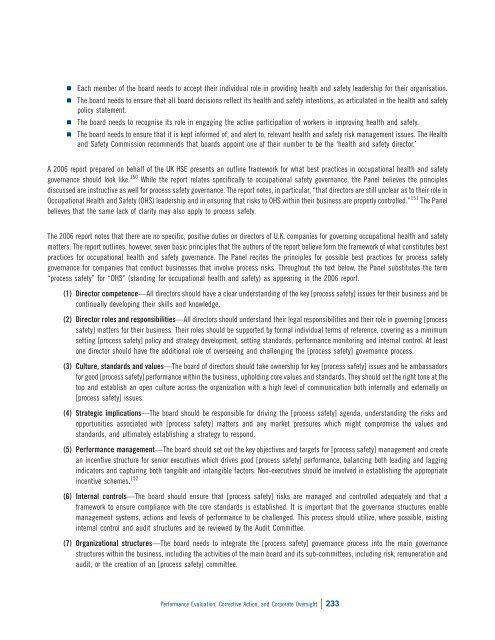The Baker Panel Report - ABSA
The Baker Panel Report - ABSA
The Baker Panel Report - ABSA
Create successful ePaper yourself
Turn your PDF publications into a flip-book with our unique Google optimized e-Paper software.
Each member of the board needs to accept their individual role in providing health and safety leadership for their organisation. <strong>The</strong> board needs to ensure that all board decisions reflect its health and safety intentions, as articulated in the health and safetypolicy statement. <strong>The</strong> board needs to recognise its role in engaging the active participation of workers in improving health and safety. <strong>The</strong> board needs to ensure that it is kept informed of, and alert to, relevant health and safety risk management issues. <strong>The</strong> Healthand Safety Commission recommends that boards appoint one of their number to be the ‘health and safety director.’A 2006 report prepared on behalf of the UK HSE presents an outline framework for what best practices in occupational health and safetygovernance should look like. 150 While the report relates specifically to occupational safety governance, the <strong>Panel</strong> believes the principlesdiscussed are instructive as well for process safety governance. <strong>The</strong> report notes, in particular, “that directors are still unclear as to their role inOccupational Health and Safety (OHS) leadership and in ensuring that risks to OHS within their business are properly controlled.” 151 <strong>The</strong> <strong>Panel</strong>believes that the same lack of clarity may also apply to process safety.<strong>The</strong> 2006 report notes that there are no specific, positive duties on directors of U.K. companies for governing occupational health and safetymatters. <strong>The</strong> report outlines, however, seven basic principles that the authors of the report believe form the framework of what constitutes bestpractices for occupational health and safety governance. <strong>The</strong> <strong>Panel</strong> recites the principles for possible best practices for process safetygovernance for companies that conduct businesses that involve process risks. Throughout the text below, the <strong>Panel</strong> substitutes the term“process safety” for “OHS” (standing for occupational health and safety) as appearing in the 2006 report.(1) Director competence—All directors should have a clear understanding of the key [process safety] issues for their business and becontinually developing their skills and knowledge.(2) Director roles and responsibilities—All directors should understand their legal responsibilities and their role in governing [processsafety] matters for their business. <strong>The</strong>ir roles should be supported by formal individual terms of reference, covering as a minimumsetting [process safety] policy and strategy development, setting standards, performance monitoring and internal control. At leastone director should have the additional role of overseeing and challenging the [process safety] governance process.(3) Culture, standards and values—<strong>The</strong> board of directors should take ownership for key [process safety] issues and be ambassadorsfor good [process safety] performance within the business, upholding core values and standards. <strong>The</strong>y should set the right tone at thetop and establish an open culture across the organization with a high level of communication both internally and externally on[process safety] issues.(4) Strategic implications—<strong>The</strong> board should be responsible for driving the [process safety] agenda, understanding the risks andopportunities associated with [process safety] matters and any market pressures which might compromise the values andstandards, and ultimately establishing a strategy to respond.(5) Performance management—<strong>The</strong> board should set out the key objectives and targets for [process safety] management and createan incentive structure for senior executives which drives good [process safety] performance, balancing both leading and laggingindicators and capturing both tangible and intangible factors. Non-executives should be involved in establishing the appropriateincentive schemes. 152(6) Internal controls—<strong>The</strong> board should ensure that [process safety] risks are managed and controlled adequately and that aframework to ensure compliance with the core standards is established. It is important that the governance structures enablemanagement systems, actions and levels of performance to be challenged. This process should utilize, where possible, existinginternal control and audit structures and be reviewed by the Audit Committee.(7) Organizational structures—<strong>The</strong> board needs to integrate the [process safety] governance process into the main governancestructures within the business, including the activities of the main board and its sub-committees, including risk, remuneration andaudit, or the creation of an [process safety] committee.Performance Evaluation, Corrective Action, and Corporate Oversight C 233

















